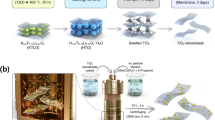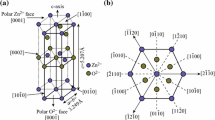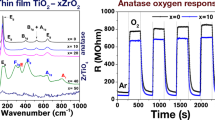Abstract
In this study, three different TiO2 nanostructures, including nanowires, nanoparticles, and thin films, were synthesized by three different processes. The morphology and crystal structure of the three different TiO2 structures deposited on quartz glasses were characterized by XRD, SEM, FTIR, and BET. It has been found that nanowires and nanoparticles showed only the anatase phase, while the thin films exhibited both anatase and rutile phases. The three TiO2 nanostructures were then used to fabricate gas sensors for ammonia (NH3) detection at different concentrations and various conditions. The samples fabricated with TiO2 thin film toward 50 ppm NH3 showed a response value of 5% at room temperature, whereas the other two samples exhibited much higher values toward similar condition NH3 at room temperature. Samples with nanowires showed a threefold increase and samples with nanoparticles exhibit a twofold increase in response value. We have found that the response of all samples increases with the elevating operating temperature up to 200 °C. Increasing the operating temperature improved the nanoparticle sensing conditions more than the other two samples. The samples using nanoparticles showed a 33% increase in response toward 50 ppm NH3 at 200 °C compared to the samples with thin films at similar conditions. Further, response and recovery time were investigated and reported in this study.












Similar content being viewed by others
References
A. Dey, Semiconductor metal oxide gas sensors: a review. Mater. Sci. Eng., B 229, 206–217 (2018)
M. Hadiyan, A. Salehi, A. Koohi-Saadi, Sub-ppm acetone gas sensing properties of free-standing ZnO nanorods. J. Electroceram. 42, 147–155 (2019)
C. De Pascali, M.A. Signore, A. Taurino, L. Francioso, A. Macagnano, J. Avossa et al., Investigation of the gas-sensing performance of electrospun TiO2 nanofiber-based sensors for ethanol sensing. IEEE Sens. J. 18, 7365–7374 (2018)
M. Shooshtari, A. Salehi, S. Vollebregt, Effect of humidity on gas sensing performance of carbon nanotube gas sensors operated at room temperature. IEEE Sens. J. 21, 5763–5770 (2020)
J. Zhang, X. Liu, G. Neri, N. Pinna, Nanostructured materials for room-temperature gas sensors. Adv. Mater. 28, 795–831 (2016)
M.-H. Seo, M. Yuasa, T. Kida, J.-S. Huh, K. Shimanoe, N. Yamazoe, Gas sensing characteristics and porosity control of nanostructured films composed of TiO2 nanotubes. Sens. Actuators B 137, 513–520 (2009)
Salehi A, Kalantari D J, Goshtasbi A (2006) Rapid response of Au/porous-GaAs humidity sensor at room temperature in 2006 Conference on optoelectronic and microelectronic materials and devices, pp 125-128
V. Galstyan, E. Comini, C. Baratto, G. Faglia, G. Sberveglieri, Nanostructured ZnO chemical gas sensors. Ceram. Int. 41, 14239–14244 (2015)
B. Yuliarto, L. Nulhakim, M.F. Ramadhani, M. Iqbal, A. Nuruddin, Improved performances of ethanol sensor fabricated on Al-doped ZnO nanosheet thin films. IEEE Sens. J. 15, 4114–4120 (2015)
P.T. Moseley, Progress in the development of semiconducting metal oxide gas sensors: a review. Meas. Sci. Technol. 28, 082001 (2017)
A. Aoboun, B. Cherdhirunkorn, C. Pechyen, Development of screen printed electrode using MWCNTs–TiO2 nanocomposite as a low-cost device for uric acid detection in urine. J. Mater. Sci. 30, 2403–2412 (2019)
S. Sakib, R. Pandey, L. Soleymani, I. Zhitomirsky, Surface modification of TiO2 for photoelectrochemical DNA biosensors. Med. Devices Sens. 3, e10066 (2020)
S. Wategaonkar, R. Pawar, V. Parale, D. Nade, B. Sargar, R. Mane, Synthesis of rutile TiO2 nanostructures by single step hydrothermal route and its characterization. Mater. Today 23, 444–451 (2020)
I. Cappelli, A. Fort, A. Lo Grasso, E. Panzardi, M. Mugnaini, V. Vignoli, RH sensing by means of TiO2 Nanoparticles: a comparison among different sensing techniques based on modeling and chemical/physical interpretation. Chemosensors 8, 89 (2020)
P. Karthik, P. Gowthaman, M. Venkatachalam, A. Rajamanickam, Propose of high performance resistive type H2S and CO2 gas sensing response of reduced graphene oxide/titanium oxide (rGO/TiO2) hybrid sensors. J. Mater. Sci. 31, 3695–3705 (2020)
V. Ganbavle, S. Inamdar, G. Agawane, J. Kim, K. Rajpure, Synthesis of fast response, highly sensitive and selective Ni: ZnO based NO2 sensor. Chem. Eng. J. 286, 36–47 (2016)
X. Chen, A. Selloni, Introduction: Titanium Dioxide (TiO2) Nanomaterials (ACS Publications, Washington, 2014).
B. Comert, N. Akin, M. Donmez, S. Saglam, S. Ozcelik, Titanium dioxide thin films as methane gas sensors. IEEE Sens. J. 16, 8890–8896 (2016)
E. Bet-Moushoul, Y. Mansourpanah, K. Farhadi, M. Tabatabaei, TiO2 nanocomposite based polymeric membranes: a review on performance improvement for various applications in chemical engineering processes. Chem. Eng. J. 283, 29–46 (2016)
Z. Li, Z. Yao, A.A. Haidry, T. Plecenik, L. Xie, L. Sun et al., Resistive-type hydrogen gas sensor based on TiO2: a review. Int. J. Hydrog Energy 43, 21114–21132 (2018)
O. Krško, T. Plecenik, T. Roch, B. Grančič, L. Satrapinskyy, M. Truchlý et al., Flexible highly sensitive hydrogen gas sensor based on a TiO2 thin film on polyimide foil. Sens. Actuators B 240, 1058–1065 (2017)
X. Zhou, Y. Wang, J. Wang, Z. Xie, X. Wu, N. Han et al., Amplifying the signal of metal oxide gas sensors for low concentration gas detection. IEEE Sens. J. 17, 2841–2847 (2017)
B. Lyson-Sypien, M. Radecka, M. Rekas, K. Swierczek, K. Michalow-Mauke, T. Graule et al., Grain-size-dependent gas-sensing properties of TiO2 nanomaterials. Sens. Actuators B 211, 67–76 (2015)
G. Eranna, B. Joshi, D. Runthala, R. Gupta, Oxide materials for development of integrated gas sensors—a comprehensive review. Crit. Rev. Solid State Mater. Sci. 29, 111–188 (2004)
H. Wu, Z. Ma, Z. Lin, H. Song, S. Yan, Y. Shi, High-sensitive ammonia sensors based on tin monoxide nanoshells. Nanomaterials 9, 388 (2019)
M. Hakimi, A. Salehi, F. Boroumand, N. Mosleh, Fabrication of a room temperature ammonia gas sensor based on polyaniline with N-doped graphene quantum dots. IEEE Sens. J. 18, 2245–2252 (2018)
J.N. Gavgani, A. Hasani, M. Nouri, M. Mahyari, A. Salehi, Highly sensitive and flexible ammonia sensor based on S and N co-doped graphene quantum dots/polyaniline hybrid at room temperature. Sens. Actuators B 229, 239–248 (2016)
S.S. Al-Taweel, H.R. Saud, New route for synthesis of pure anatase TiO2 nanoparticles via ultrasound assisted sol-gel method. J. Chem. Pharm. Res. 8, 620–626 (2016)
R. Nankya, K.-N. Kim, Sol–gel synthesis and characterization of Cu–TiO2 nanoparticles with enhanced optical and photocatalytic properties. J. Nanosci. Nanotechnol. 16, 11631–11634 (2016)
B.K. Mutuma, G.N. Shao, W.D. Kim, H.T. Kim, Sol–gel synthesis of mesoporous anatase–brookite and anatase–brookite–rutile TiO2 nanoparticles and their photocatalytic properties. J. Colloid Interface Sci. 442, 1–7 (2015)
O. Wiranwetchayan, S. Promnopas, T. Thongtem, A. Chaipanich, S. Thongtem, Effect of alcohol solvents on TiO2 films prepared by sol–gel method. Surf. Coat. Technol. 326, 310–315 (2017)
D.V. Bavykin, J.M. Friedrich, F.C. Walsh, Protonated titanates and TiO2 nanostructured materials: synthesis, properties, and applications. Adv. Mater. 18, 2807–2824 (2006)
P. Liu, W. Cai, M. Fang, Z. Li, H. Zeng, J. Hu et al., Room temperature synthesized rutile TiO2 nanoparticles induced by laser ablation in liquid and their photocatalytic activity. Nanotechnology 20, 285707 (2009)
Y. Wu, P. Yang, Direct observation of vapor−liquid−solid nanowire growth. J. Am. Chem. Soc. 123, 3165–3166 (2001)
S.K. Pradhan, P.J. Reucroft, F. Yang, A. Dozier, Growth of TiO2 nanorods by metalorganic chemical vapor deposition. J. Cryst. Growth 256, 83–88 (2003)
H. Shang, G. Cao, Template-based synthesis of nanorod or nanowire arrays, in Springer handbook of nanotechnology. ed. by B. Bhushan (Springer, Berlin, 2007), pp. 161–178
M. Ge, J. Cai, J. Iocozzia, C. Cao, J. Huang, X. Zhang et al., A review of TiO2 nanostructured catalysts for sustainable H2 generation. Int J Hydrog Energy 42, 8418–8449 (2017)
M. Ferroni, V. Guidi, G. Martinelli, G. Faglia, P. Nelli, G. Sberveglieri, Characterization of a nanosized TiO2 gas sensor. Nanostruct. Mater. 7, 709–718 (1996)
A. León, P. Reuquen, C. Garín, R. Segura, P. Vargas, P. Zapata et al., FTIR and Raman characterization of TiO2 nanoparticles coated with polyethylene glycol as carrier for 2-methoxyestradiol. Appl. Sci. 7, 49 (2017)
S. de Castro, A.F. da Silva, J.F. Felix, M.R. Piton, H.V.A. Galeti, A.D.G. Rodrigues et al., Effect of growth techniques on the structural, optical and electrical properties of indium doped TiO2 thin films. J. Alloy. Compd. 766, 194–203 (2018)
G. Karunakaran, E. BumCho, Role of block copolymer template for tailoring crystal structure and band gap of titania in mesoporous silica and organosilica particles. Ceram. Int. 46, 2163–2172 (2020)
M. Zulfiqar, S. Sufian, N. Mansor, N.E. Rabat, Synthesis and characterization of TiO2-based nanostructures via fluorine-free solvothermal method for enhancing visible light photocatalytic activity: experimental and theoretical approach. J. Photochem. Photobiol. A 404, 112834 (2021)
Y. Kwon, H. Kim, S. Lee, I.-J. Chin, T.-Y. Seong, W.I. Lee et al., Enhanced ethanol sensing properties of TiO2 nanotube sensors. Sens. Actuators B 173, 441–446 (2012)
H. Shang, M. Li, H. Li, S. Huang, C. Mao, Z. Ai et al., Oxygen vacancies promoted the selective photocatalytic removal of NO with blue TiO2 via simultaneous molecular oxygen activation and photogenerated hole annihilation. Environ. Sci. Technol. 53, 6444–6453 (2019)
L. Xu, X. Ma, N. Sun, F. Chen, Bulk oxygen vacancies enriched TiO2 and its enhanced visible photocatalytic performance. Appl. Surf. Sci. 441, 150–155 (2018)
S. Ramanavicius, A. Ramanavicius, Insights in the application of stoichiometric and non-stoichiometric titanium oxides for the design of sensors for the determination of gases and VOCs (TiO2−x and TinO2n−1 vs. TiO2). Sensors 20, 6833 (2020)
Gwizdz P, Radecka M, Zakrzewska K (2018) Array of Gas Sensors Based on TiO2 upon Temperature Modulation in 2018 XV International scientific conference on Optoelectronic and Electronic Sensors (COE), pp 1-4
C.-H. Lin, C.-H. Liao, W.-H. Chen, C.-Y. Chou, C.-Y. Liu, Fabrication of p-type TiO2 and transparent p-TiO2/n-ITO pn junctions. AIP Adv. 9, 045229 (2019)
S. Lin, D. Li, J. Wu, X. Li, S. Akbar, A selective room temperature formaldehyde gas sensor using TiO2 nanotube arrays. Sens. Actuators B 156, 505–509 (2011)
W. Wang, F. Liu, B. Wang, Y. Wang, Effect of defects in TiO2 nanoplates with exposed 001 facets on the gas sensing properties. Chin. Chem. Lett. 30, 1261–1265 (2019)
M. Tabatabaei, H.G. Fard, J. Koohsorkhi, Low-temperature preparation of a carbon nanotube–ZnO hybrid on glass substrate for field emission applications. NANO 10, 1550040 (2015)
Author information
Authors and Affiliations
Corresponding author
Ethics declarations
Conflict of interest
The authors declare that they have no known competing financial interests or personal relationships that could have appeared to influence the work reported in this paper.
Additional information
Publisher's Note
Springer Nature remains neutral with regard to jurisdictional claims in published maps and institutional affiliations.
Rights and permissions
About this article
Cite this article
Shooshtari, M., Salehi, A. Ammonia room-temperature gas sensor using different TiO2 nanostructures. J Mater Sci: Mater Electron 32, 17371–17381 (2021). https://doi.org/10.1007/s10854-021-06269-8
Received:
Accepted:
Published:
Issue Date:
DOI: https://doi.org/10.1007/s10854-021-06269-8




